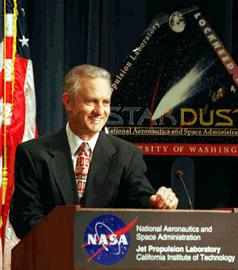STARDUST Status Report
December 18, 1998

Ken
Atkins
STARDUST Project Manager
Merry Christmas from the STARDUST Team.
These last few weeks have been busy but with significant progress. As you
have seen, if you've been following the action on the webcam
(http://stardust.jpl.nasa.gov/photo/webcam.html), the spacecraft has been opened so that
some of the electronic boxes that didn't come with the spacecraft earlier
could be installed and some additional heaters for the propellant lines could
be added. With this all done the spacecraft was closed up again and moved to
its tilt and rotation fixture. Then the new flight software (STARDUST's
"brain") was loaded into its computers. Power was applied and functional
testing began. The fault protection functions (e.g. emergency procedures) such
as electrical load shedding, power management, and attitude control were given
preliminary tests. Command sequencing for launch, communications, and
trajectory correction were also in the test mix. STARDUST was then
tilted to horizontal so the sample return capsule (SRC) could be opened
inside an environmentally controlled "glovebox." Last week our Science
Principal Investigator, Professor Don Brownlee, came down from Seattle to
do a final inspection, aided by the project quality inspector, of the aerogel.
The sample return capsule (SRC) was commanded to open and the collector was
deployed. He gave a solid "thumbs up" for the readiness of the collector
and the capsule was closed for the last time. Yesterday, STARDUST was moved
back to its vertical handling dolly and the solar arrays (that change
sunlight to electricity) were installed.
After the successful launch last week of the Mars Climate Orbiter from Pad
17A, the launch teams have begun to refurbish the pad for the erection of our
Delta II rocket. The rocket itself is now here at Kennedy Space Center and
in preparation for beginning the build-up of stages next week.
On the operations front, much work has been done to prepare for the
countdown-to-launch and the initial acquistion of STARDUST's telemetry after
separation from the launch rocket. With procedures maturing, the team will
start rehearsals for the countdown next week. Also, a test was begun of the
end-to-end communication link from the spacecraft through the Deep Space
Network (DSN).
As you can tell, it's a very exciting time here on the Space Coast in
Florida. Some of us were even able to go out to the Shuttle Landing Site
last week to see the Shuttle come home from space. We also were "rookie"
trainees the week before on consoles for the Mars Orbiter launch. And right
after New Years, we'll watch the Mars Lander launch from
Pad 17B.
Overlaying all this, of course, is the Christmas and Holiday season. On behalf
of all of us on the STARDUST team, I extend best wishes for a blessed and safe
time. After the holiday, we'll be just a month away from our launch on
February 6. We are looking forward to many of you being here to share that
event in person and, for everyone else, be sure to plan to be with us on TV
(NASA TV).
For more information
on the STARDUST mission - the first ever comet sample
return mission -
please visit the STARDUST home page: http://stardust.jpl.nasa.gov
